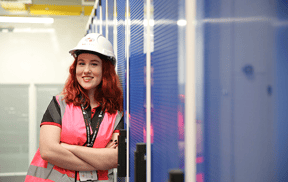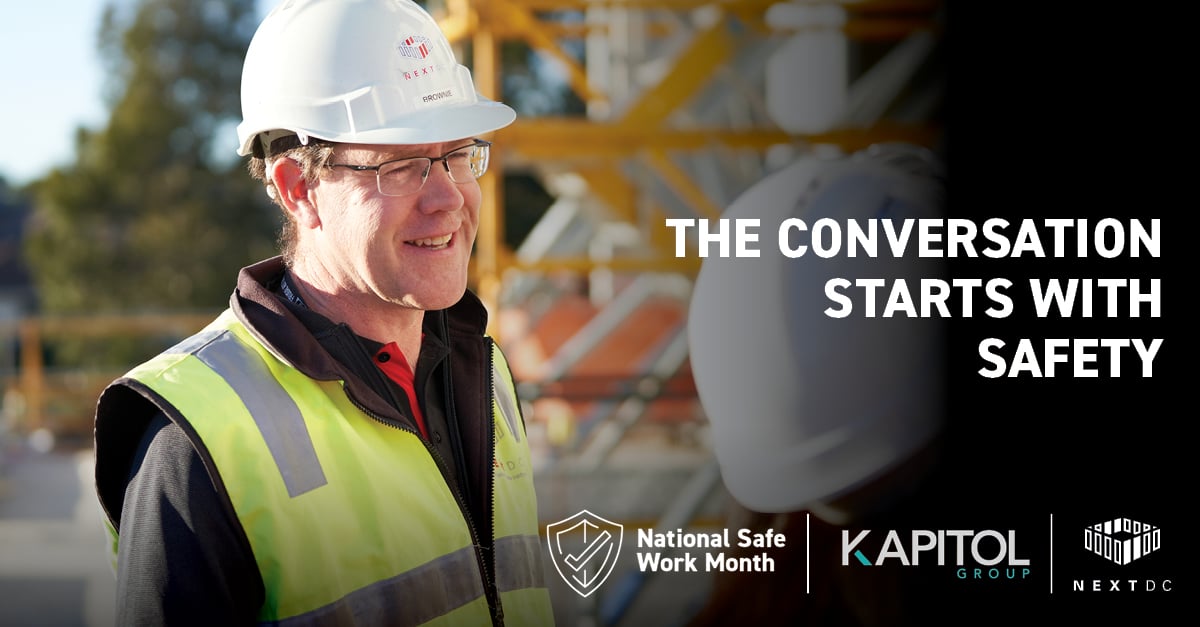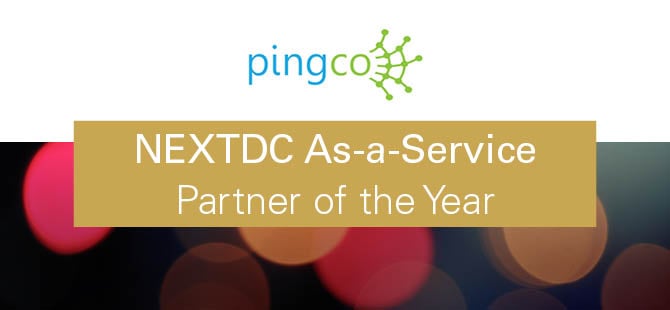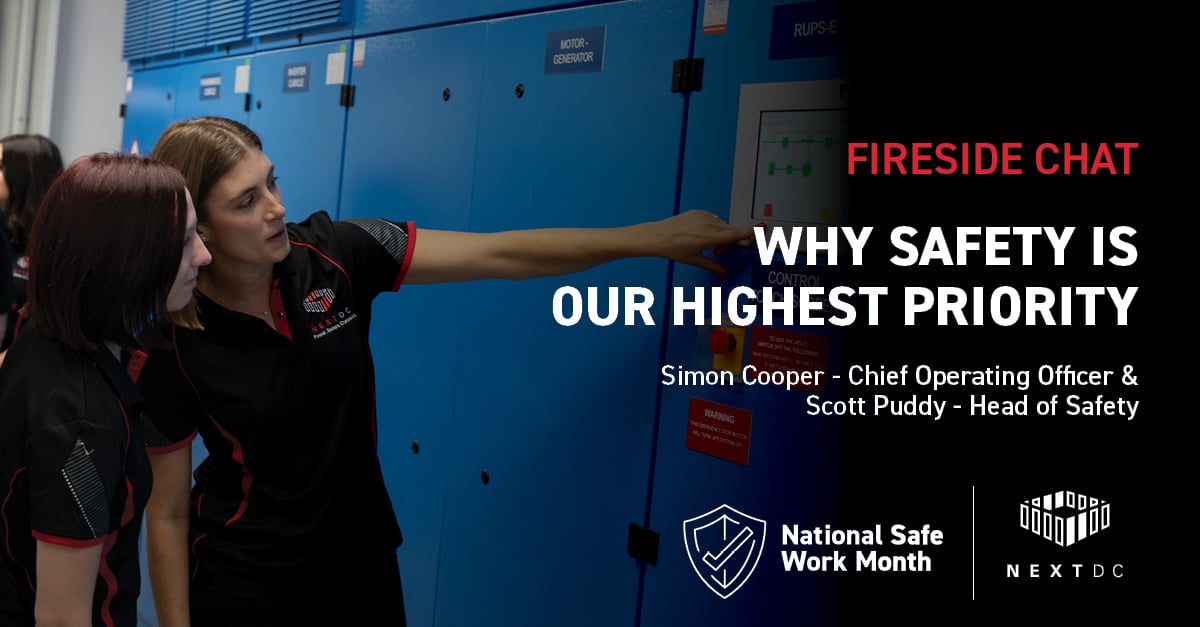In Part 1 of our CXO fireside chat, we explored what safety best practice looks like and NEXTDC’s approach to maintaining it. Today, we dive a little deeper to better understand the unique challenges in keeping our teams, customers and contractors safe and how COVID introduced a new dynamic to our safety discipline.
We have diverse work functions including administrative, facilities management and construction; how different is the approach required for each work environment?
Scott Puddy, Head of Safety (SP): The approach is essentially the same. It’s about educating teams so they’re aware of potential hazards and what controls we need to have in place. In the office it might be mental health, cuts, slips, ergonomics etc. Construction obviously will have different hazards, but the approach to safety has a common philosophy; proactive hazard awareness, led by data and the safety first conversation in everything we do.
Simon Cooper, Chief Operating Officer (SC): Education is key across the board. It’s essential we continue to provide necessary tools and training and create a culture that empowers everyone to have ‘safety first’ conversations. When you’re under pressure to deliver something, we have to provide the environment where every individual feels empowered to put safety first and say “stop! this isn’t safe”. If people think that “we don’t need to worry about safety anymore” because we hired a Head of Safety, then we’ve failed.

How has COVID-19 changed the safety conversation in 2020?
SC: It’s given us the opportunity to mobilise quickly. Our operational team quickly established a raft of best working practices that enabled us to take a staged approach to a national standard across the business. We immediately went out and secured additional materials, to deliver on the COVID-safe plans. Cleaning experts were consulted to enable higher standards of proactive cleaning and response readiness if a confirmed infection in any of our facilities was identified. We very quickly figured out that it was essential to communicate that our COVID response was intimately linked to safety. COVID is highly infectious and dangerous, so we had to protect our teams, customers and contractors from catching it. It is also really important that we focus on the mental health issues; anxiety about the pandemic and being isolated from colleagues and loved ones. COVID required enhanced, bespoke action on safety and, overall, I am really proud of how our teams dealt with it.
SP:We have dealt with SARS in the past, so there was some pandemic experience for safety practitioners to draw upon. What I have seen from NEXTDC around COVID is a very smooth, well-oiled machine that is continuing to operate under some extreme restrictions, particularly in Melbourne. I think our ‘Scaling-Up’ methodology has put us in good stead. The daily huddles and weekly check-in meeting rhythm our team is used to has really helped people connect, support each other and maintain focus. I know from conversations with peers that lots of organisations struggled with this. Essentially, COVID-19 is just another safety hazard which we need to manage.
There are a lot of metrics in safety. What are we measuring? What are the critical numbers targeted around safety?
SP: We report all the typical safety indicators as is mandated, which is largely to do with measuring what has gone wrong. We need to shift our primary focus toward gathering the lead indicators and building a reporting cadence around prevention. It has to be more than reporting on traditional lost time and injury frequency rates. We are moving to ‘hazards identified’ and ‘safety walks conducted’ type metrics. This is also the way we’re embracing safety with our construction partners. There is a lot we can learn from the way they’re proactively managing safety on site.
SC: What’s important is the regular output of that reporting. All of the above is correct, we are focusing on reducing risk. But over and above that, we as a CXO team need this safety information in a cadence that is digestible and leads to conversation and clarity around how we are performing. Seeing this information shared on a regular basis and knowing that people are reviewing trends, is vital.
The ‘Pursuit of Excellence’ is a NEXTDC corporate value. How does this translate to safety?
SC: Our overall goal is embedding safety into all of our processes, so it becomes part of a business-as-usual flow. The National Operations Excellence program we have built is an internal capability to collectively understand what our best operating practices are, and then ensuring we have training and measures in place to achieve them. We are creating a series of connected feedback loops to drive improvement. This already has safety embedded in it. What we want to do over time is increase awareness about safety and ensure that data is captured everywhere. We have commenced this journey and we have a national environment with a national team that works together and thinks together. This culture of pursuing excellence creates a strong lever in support of continuously raising the health & safety bar.
SP: I agree with Simon’s comments. The journey is well underway and there are some great initiatives in play. Our next step is to broaden the focus up and down our supply chain. It’s about looking across our operations but also our procurement practices, how safety can be further entrenched in everything we do and even through to the customer experience. We have a strong executive sponsorship so we know this will only continue to strengthen.
Stay safe, stay aware
When the clock tick’s over to November and safety month officially ends, it doesn’t mean your guard should come down. Make safety a part of your every day personal and professional life. It’s a choice we choose to make every day, and we’ve never lived to regret it. You won’t either.
If you would like to understand how NEXTDC can support your critical IT operations and ensure you and your teams' safety is continually top of mind, reach out and speak with a specialist.


